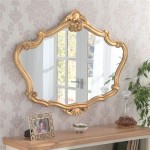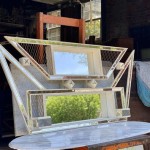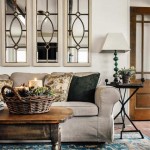Types of Mirrors for Home Office Space
Mirrors are versatile decorative and functional elements that can significantly enhance a home office. They not only serve the primary purpose of reflection but also contribute to the perceived size, brightness, and overall aesthetic of the workspace. Selecting the right type of mirror requires careful consideration of the office's layout, style, and the specific effects one wishes to achieve.
Enhancing Light and Space with Wall Mirrors
Wall mirrors are a common choice for home offices due to their ability to reflect light and create a sense of spaciousness. By strategically positioning a wall mirror near a window or light source, it's possible to amplify the natural or artificial light within the room, reducing the need for excessive lighting fixtures. This is particularly beneficial in smaller offices or those with limited natural light.
The size of the wall mirror is an important factor. A large wall mirror can effectively double the visual size of the room, making it feel more open and airy. Conversely, smaller mirrors or a collection of smaller mirrors can add a decorative touch without overwhelming the space. The shape of the mirror also influences its impact; rectangular mirrors tend to elongate the room, while round or oval mirrors soften the angles and create a more relaxed atmosphere.
Framed wall mirrors offer an opportunity to integrate the mirror seamlessly into the office's existing décor. The frame can match the color scheme, material, or style of other furniture and accessories in the room. Frameless mirrors, on the other hand, provide a minimalist and modern aesthetic, often appealing to those seeking a clean and uncluttered look.
Installation of wall mirrors should be approached with caution. Securing the mirror properly to the wall is crucial to prevent accidents. Consider the weight of the mirror and the type of wall material when choosing appropriate mounting hardware. Professional installation is recommended for large or heavy mirrors.
Full-Length Mirrors: Functionality and Style
While not always immediately considered for a home office, full-length mirrors can be surprisingly useful and visually appealing. Beyond their obvious function of providing a full-body reflection, they contribute to the sense of spaciousness in the room, similar to wall mirrors. They can also serve as a focal point, adding a touch of elegance or modernity to the office décor.
Full-length mirrors come in various styles. Leaning mirrors, which are placed against the wall without being mounted, offer a casual and contemporary look. These are easy to move and reposition as needed. Standing mirrors, with their own supporting frames or stands, provide stability and flexibility in placement. Wall-mounted full-length mirrors offer a more permanent solution, often preferred for their streamlined appearance and security.
The placement of a full-length mirror is important. Ideally, it should be positioned in a location where it doesn't obstruct movement or create glare on computer screens. Consider placing it in a corner or along a wall that is not frequently used. Using a full-length mirror behind a door can also be an efficient use of space.
From a practical standpoint, a full-length mirror allows one to quickly assess their appearance before video conferences or client meetings. It can also encourage better posture by providing visual feedback throughout the workday. The addition of a full-length mirror to a home office can blend functionality with personal grooming needs.
Decorative Mirrors: Adding Character and Interest
Decorative mirrors serve primarily to enhance the aesthetic appeal of the home office. These mirrors often feature unique shapes, intricate frames, or artistic designs. They can be used to create a focal point, add pops of color, or reflect the personal style of the occupant.
Sunburst mirrors, with their radiating designs, are a popular choice for adding a touch of glamour and vintage charm. Geometric mirrors, with their clean lines and angular shapes, offer a modern and contemporary aesthetic. Antique mirrors, with their distressed finishes and ornate frames, can evoke a sense of history and sophistication. The options are virtually limitless, allowing one to select a decorative mirror that perfectly complements the overall décor of the office.
Small decorative mirrors can be grouped together to create a gallery wall effect. This is a creative way to fill empty wall space and add visual interest. Consider mixing different shapes, sizes, and frame styles to create a dynamic and eclectic display. Alternatively, a single statement mirror can serve as a focal point above a desk or credenza.
The framing of decorative mirrors is a key element. Frames can be made from a variety of materials, including wood, metal, glass, or resin. Consider the color, texture, and detail of the frame when selecting a decorative mirror. The frame should complement the mirror itself and the surrounding décor.
The strategic placement of decorative mirrors can enhance the ambiance of the office. Placing a decorative mirror opposite a window or doorway can draw the eye and create a sense of depth. Using decorative mirrors to reflect artwork or plants can amplify their visual impact. When selecting decorative mirrors, consider how they will interact with the existing elements of the room.
Desk Mirrors: Functionality at Arm's Reach
Desk mirrors are a smaller, more intimate option that provides functionality without occupying significant wall space. They are especially useful for tasks that require close-up attention to detail or for quick grooming checks throughout the workday.
These mirrors typically come in two forms: freestanding vanity mirrors and adjustable makeup mirrors. Freestanding vanity mirrors often feature a decorative base and can be easily moved and repositioned on the desk. Adjustable makeup mirrors often have a tilting or swiveling mechanism, allowing for optimal viewing angles. Some models also include magnification options, which are particularly helpful for tasks such as applying makeup or examining small objects.
When choosing a desk mirror, consider its size and shape. A smaller mirror is ideal for a compact desk, while a larger mirror may be more suitable for a spacious workspace. The shape of the mirror can also influence its functionality. A round mirror provides a softer, more flattering reflection, while a rectangular mirror offers a wider field of view.
Illuminated desk mirrors are a popular option, offering built-in lighting that can improve visibility and reduce eye strain. LED lighting is often preferred for its energy efficiency and natural-looking light quality. Consider the brightness and color temperature of the lighting when selecting an illuminated desk mirror.
Placement is crucial for desk mirrors. Position the mirror in a location where it is easily accessible but doesn't obstruct your view of your computer screen or other important items. Consider placing it to the side of your desk or on a nearby shelf.
Considerations for Purchasing Mirrors
Before purchasing any type of mirror for a home office, several factors should be considered. First, assess the existing décor of the office and choose a mirror that complements the overall style. Consider the color scheme, materials, and design elements of the surrounding furniture and accessories.
Second, evaluate the size and shape of the office space. A small office may benefit from a large wall mirror or full-length mirror to create a sense of spaciousness. A larger office can accommodate multiple mirrors or more elaborate decorative mirrors.
Third, consider the primary function of the mirror. If the primary goal is to enhance light and space, a large, frameless wall mirror may be the best option. If the primary goal is to add aesthetic appeal, a decorative mirror with a unique frame or design may be more suitable. If the primary goal is to provide personal grooming assistance, a desk mirror with magnification or lighting may be the most practical choice.
Fourth, evaluate the quality of the mirror. Look for mirrors made from high-quality glass or acrylic. Check for any imperfections or distortions in the reflection. Ensure that the frame is sturdy and well-constructed. Always compare different brands and models before making a purchase.
Finally, consider the budget. Mirrors range in price from affordable to expensive, depending on their size, style, and materials. Set a budget before you start shopping and stick to it. Remember that it is possible to find high-quality mirrors at reasonable prices.

Reflecting Style How Mirrors In Interior Design Transform Spaces

Decorative Wall Mirrors For Fascinating Interior Spaces

Designer Mirror Ideas For Living Rooms Reflecting Elegance

Reflecting Style How Mirrors In Interior Design Transform Spaces

Entryway And Foyer Mirrors Don T Miss Out On This Design Element

20 Incredibly Clever Ways To Decorate With Mirrors In A Small Living Room Michael Helwig Interiors

Wall Mirror Design Ideas For Your Home Cafe

Biga Asymmetrical Mirror Home Decor Aesthetic Wall Bathroom Design Irregular Custom

Designer Mirror Ideas For Living Rooms Reflecting Elegance

Reflecting Style How Mirrors In Interior Design Transform Spaces







